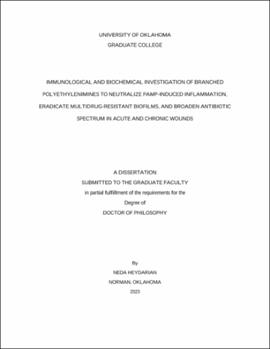| dc.description.abstract | Innate immunity has considerable specificity and can discriminate between individual species of microbes. In this regard, pathogens are “seen” as dangerous to the host and elicit an inflammatory response capable of destroying the microbes. This immune discrimination is achieved through the recognition of microbe-specific molecules (e.g., lipopolysaccharide, lipoteichoic acid, and peptidoglycan) by toll-like receptors on host cells. Lipopolysaccharide (LPS), lipoteichoic acid (LTA), and peptidoglycan (PGN) arising from dangerous bacteria are known as Pathogen-Associated Molecular Pattern (PAMP) molecules. PAMPs impede wound healing by lengthening the inflammatory phase of healing and contributing to the development of chronic wounds. Preventing PAMPs from triggering the release of inflammatory cytokines will restore the optimal inflammatory response. However, successful drugs are elusive because PAMPs originate from many different species of Gram-negative and Gram-positive bacteria. Therefore, the need exists for a universal broad-spectrum therapeutic against LPS, LTA, and PGN bacterial PAMPs. We envision our discoveries as topical agents applied to acute and chronic wounds because, in addition to the active moiety of the agent preventing TNF-α cytokine release, it also disables antibiotic resistance mechanisms and disrupts the biofilm matrix. This versatility of this agent suggests that it may be an ideal therapeutic agent for use in the hundreds of millions of non-chronic skin or soft-tissue infections (SSTIs), and the 4.5 million chronic wound infections, that occur each year. This work is innovative because we fill the technological gap with multi-purpose agents that disable PAMPs, dissolve biofilms, and overcome antibiotic resistance mechanisms, making them superior to existing technology. | en_US |
